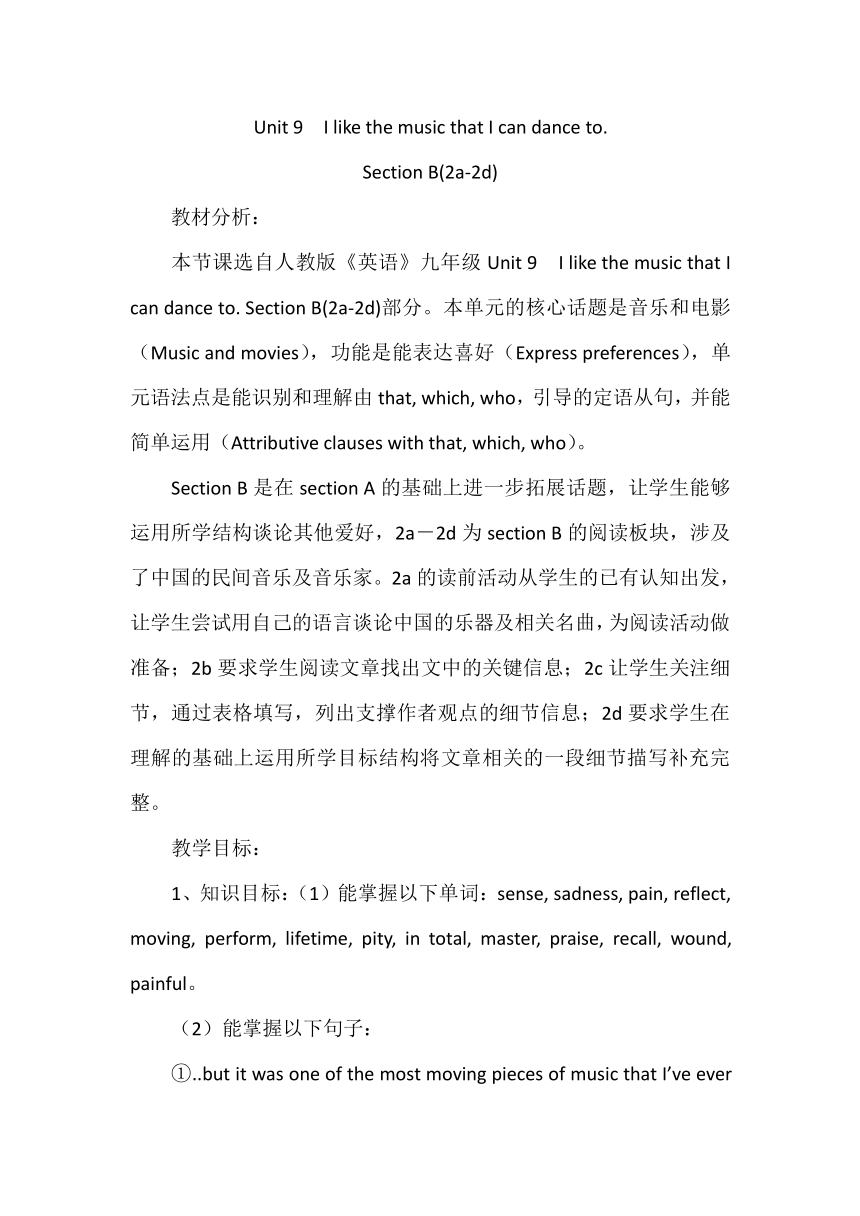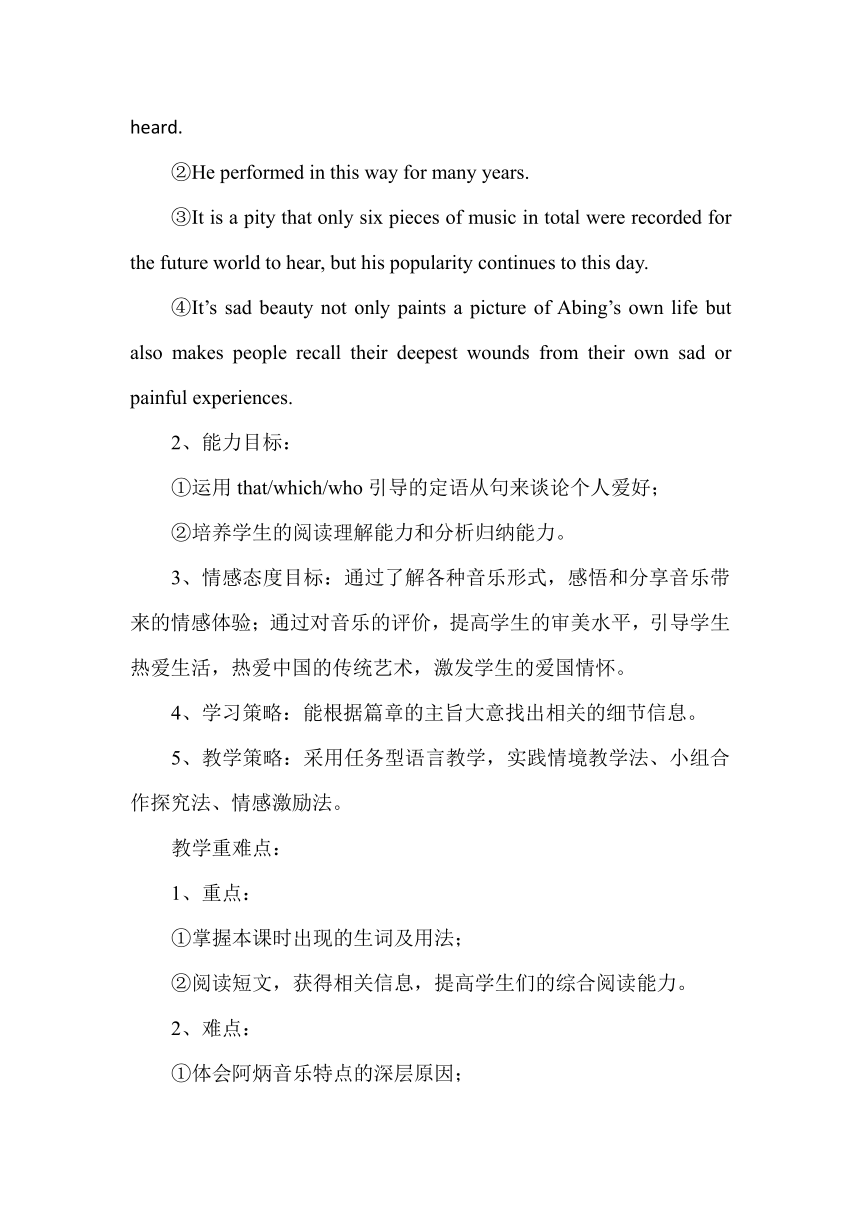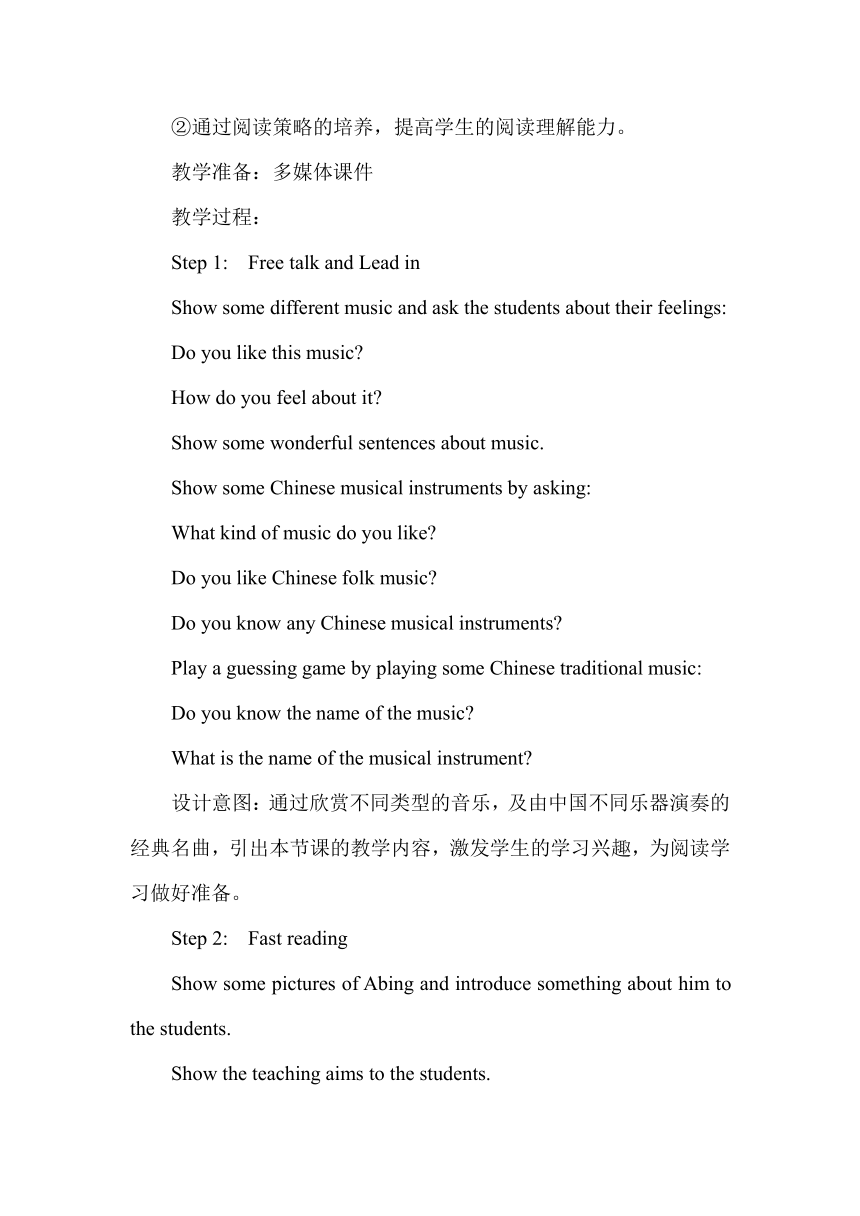人教版九年级全册英语 Unit9 I like music that I can dance to. SectionB 2a-2d 教案
文档属性
| 名称 | 人教版九年级全册英语 Unit9 I like music that I can dance to. SectionB 2a-2d 教案 |  | |
| 格式 | doc | ||
| 文件大小 | 384.5KB | ||
| 资源类型 | 教案 | ||
| 版本资源 | 人教新目标(Go for it)版 | ||
| 科目 | 英语 | ||
| 更新时间 | 2022-12-26 19:14:37 | ||
图片预览




文档简介
Unit 9 I like the music that I can dance to.
Section B(2a-2d)
教材分析:
本节课选自人教版《英语》九年级Unit 9 I like the music that I can dance to. Section B(2a-2d)部分。本单元的核心话题是音乐和电影(Music and movies),功能是能表达喜好(Express preferences),单元语法点是能识别和理解由that, which, who,引导的定语从句,并能简单运用(Attributive clauses with that, which, who)。
Section B是在section A的基础上进一步拓展话题,让学生能够运用所学结构谈论其他爱好,2a-2d为section B的阅读板块,涉及了中国的民间音乐及音乐家。2a的读前活动从学生的已有认知出发,让学生尝试用自己的语言谈论中国的乐器及相关名曲,为阅读活动做准备;2b要求学生阅读文章找出文中的关键信息;2c让学生关注细节,通过表格填写,列出支撑作者观点的细节信息;2d要求学生在理解的基础上运用所学目标结构将文章相关的一段细节描写补充完整。
教学目标:
1、知识目标:(1)能掌握以下单词:sense, sadness, pain, reflect, moving, perform, lifetime, pity, in total, master, praise, recall, wound, painful。
(2)能掌握以下句子:
①..but it was one of the most moving pieces of music that I’ve ever heard.
②He performed in this way for many years.
③It is a pity that only six pieces of music in total were recorded for the future world to hear, but his popularity continues to this day.
④It’s sad beauty not only paints a picture of Abing’s own life but also makes people recall their deepest wounds from their own sad or painful experiences.
2、能力目标:
①运用that/which/who引导的定语从句来谈论个人爱好;
②培养学生的阅读理解能力和分析归纳能力。
3、情感态度目标:通过了解各种音乐形式,感悟和分享音乐带来的情感体验;通过对音乐的评价,提高学生的审美水平,引导学生热爱生活,热爱中国的传统艺术,激发学生的爱国情怀。
4、学习策略:能根据篇章的主旨大意找出相关的细节信息。
5、教学策略:采用任务型语言教学,实践情境教学法、小组合作探究法、情感激励法。
教学重难点:
1、重点:
①掌握本课时出现的生词及用法;
②阅读短文,获得相关信息,提高学生们的综合阅读能力。
2、难点:
①体会阿炳音乐特点的深层原因;
②通过阅读策略的培养,提高学生的阅读理解能力。
教学准备:多媒体课件
教学过程:
Step 1: Free talk and Lead in
Show some different music and ask the students about their feelings:
Do you like this music
How do you feel about it
Show some wonderful sentences about music.
Show some Chinese musical instruments by asking:
What kind of music do you like
Do you like Chinese folk music
Do you know any Chinese musical instruments
Play a guessing game by playing some Chinese traditional music:
Do you know the name of the music
What is the name of the musical instrument
设计意图:通过欣赏不同类型的音乐,及由中国不同乐器演奏的经典名曲,引出本节课的教学内容,激发学生的学习兴趣,为阅读学习做好准备。
Step 2: Fast reading
Show some pictures of Abing and introduce something about him to the students.
Show the teaching aims to the students.
Let the students read the passage quickly and answer the three questions:
Which musician does the passage mainly talk about
What is the name of his most famous piece of music
How does the writer feel about this piece of music
设计意图:通过创设情境,让学生快速阅读,通过自主探究的方式,了解文章大意,培养学生快速阅读,查找相关信息的能力。
Step3: Careful reading
Show the reading skills(阅读指导)before doing careful reading.
Task One:
Let the students read the passage and find out the main idea of each paragraph.
Para. 1Para. 2Para. 3 ◆Abing's muscial skill made him popular .◆I was moved by the piece of music ErquanYingyue.◆Abing' experience.
Check the answers by asking one student.
Task Two:
Make the students and list the supporting details in each paragraph in different ways.
Paragraph 1
Ask the students to read paragraph one together and then check the answers with the students.
Main idea Supporting details (3 sentences)
I was by a piece of music named Erquan Yingyue.
Paragraph 2
Ask the students read Paragraph Two freely and find out the details.
Main idea Supporting details (5 sentences)
Abing lived a very _____ life.
Check the answers.
Paragraph 3
Make the students read Paragraph Three quietly and find out the supporting details.
Main idea Supporting details (3 sentences)
Abing’s great musical skills made him very ________.
Check the answers.
设计意图:通过任务型语言教学及阅读前的阅读技巧指导,培养学生能根据篇章的主旨大意找出相关的细节信息,能运用具体信息描写事物的能力,通过深入理解文章,让学生对音乐家阿炳的音乐特点的原因有更深层的体会。
Step 4: Post reading
Ask the students to read the passage again and understand the passage better.
Ask the students to close the book and finish Task Three: Fill in the blanks.
Exercise One:
Exercise Two: 短文填空.
Abing was a folk musician was born in Wuxi in 1893. He his mother when he was young. His father taught him to play many musical instruments, and he was for his musical ability soon. After that, ,he developed a serious illness and became blind. But he didn’t up his music .He went on his music on the streets for many years. During his lifetime, Abing play 600 pieces of music, but it’s a pity that only 6 . Among them, the famous one is Erquan Yingyue. His popularity continues to today.
Exercise Three:
Review how to use that、which、who in the relative clauses.
Zd. Grde that or who and fill in the blanks with the words in the box.
Abing played music (that/who) could touch the hearts of people. When we listen to his music, we can ______ both the beauty and the sadness in it. It makes us think about the _____ and _______ (that/who) we have experienced in the past. For this reason, many people _____ him as the musician (which/who) has greatly influenced erhu music. So it is really a ______ that not many pieces of his music were recorded.
Check the answers.
设计意图:通过三种不同形式的练习巩固加深对文章的理解,既复习本单元的语法点:定语从句,又利用短文填空的巧妙设计与中考衔接,做到学以致用。
Step 5: Group work: Writing
Show a vedio to make the students relaxed.
Tell the students that music can adjust our moods and ask them to discuss:
What kind of music do you want to listen to when you feel happy / sad / lonely…
Why
Ask two students practice with the teacher.
Show the writing task.
Writing:
研究表明,音乐对人们的情绪有着重要的影响,因此,人们用不同的音乐来调节心情。请根据下表提示内容,写一篇英语短文。
听音乐前的 情绪状态 适用音乐 听音乐后 的心境
压力大, 过分焦虑 流行音乐 放松
沉迷电脑游戏, 兴奋过度 乡村音乐 平静
困倦,疲劳 摇滚音乐 振奋
孤独,悲伤 自拟 自拟
注意: 1.词数80左右。开头已写好,不计入总词数;
2.内容必须包括上表中的要点;
3.条理清楚,语句连贯。
参考词汇: 摇滚音乐rock music
Research has shown that music has an important effect on one's moods.
__________________________________________________________________________________________________________________
Show some students’ writings.
设计意图:通过观看一段音乐视频,使学生放松,重新燃起学习兴趣,Group work中的两个活动,让学生明白音乐可调节人们的情绪,引导学生要热爱音乐、热爱生活。
Step 6: Summary
Show some famous sentences about music and make the students read loudly.
设计意图:通过大声朗读一些有关音乐的美句名言,让学生感悟音乐、感悟生活,使学生热爱生活、热爱中国传统艺术,培养学生的爱国情怀。
板书设计:
Unit 9 I like the music that I can dance to.
Section B(2a-2d)
Section B(2a-2d)
教材分析:
本节课选自人教版《英语》九年级Unit 9 I like the music that I can dance to. Section B(2a-2d)部分。本单元的核心话题是音乐和电影(Music and movies),功能是能表达喜好(Express preferences),单元语法点是能识别和理解由that, which, who,引导的定语从句,并能简单运用(Attributive clauses with that, which, who)。
Section B是在section A的基础上进一步拓展话题,让学生能够运用所学结构谈论其他爱好,2a-2d为section B的阅读板块,涉及了中国的民间音乐及音乐家。2a的读前活动从学生的已有认知出发,让学生尝试用自己的语言谈论中国的乐器及相关名曲,为阅读活动做准备;2b要求学生阅读文章找出文中的关键信息;2c让学生关注细节,通过表格填写,列出支撑作者观点的细节信息;2d要求学生在理解的基础上运用所学目标结构将文章相关的一段细节描写补充完整。
教学目标:
1、知识目标:(1)能掌握以下单词:sense, sadness, pain, reflect, moving, perform, lifetime, pity, in total, master, praise, recall, wound, painful。
(2)能掌握以下句子:
①..but it was one of the most moving pieces of music that I’ve ever heard.
②He performed in this way for many years.
③It is a pity that only six pieces of music in total were recorded for the future world to hear, but his popularity continues to this day.
④It’s sad beauty not only paints a picture of Abing’s own life but also makes people recall their deepest wounds from their own sad or painful experiences.
2、能力目标:
①运用that/which/who引导的定语从句来谈论个人爱好;
②培养学生的阅读理解能力和分析归纳能力。
3、情感态度目标:通过了解各种音乐形式,感悟和分享音乐带来的情感体验;通过对音乐的评价,提高学生的审美水平,引导学生热爱生活,热爱中国的传统艺术,激发学生的爱国情怀。
4、学习策略:能根据篇章的主旨大意找出相关的细节信息。
5、教学策略:采用任务型语言教学,实践情境教学法、小组合作探究法、情感激励法。
教学重难点:
1、重点:
①掌握本课时出现的生词及用法;
②阅读短文,获得相关信息,提高学生们的综合阅读能力。
2、难点:
①体会阿炳音乐特点的深层原因;
②通过阅读策略的培养,提高学生的阅读理解能力。
教学准备:多媒体课件
教学过程:
Step 1: Free talk and Lead in
Show some different music and ask the students about their feelings:
Do you like this music
How do you feel about it
Show some wonderful sentences about music.
Show some Chinese musical instruments by asking:
What kind of music do you like
Do you like Chinese folk music
Do you know any Chinese musical instruments
Play a guessing game by playing some Chinese traditional music:
Do you know the name of the music
What is the name of the musical instrument
设计意图:通过欣赏不同类型的音乐,及由中国不同乐器演奏的经典名曲,引出本节课的教学内容,激发学生的学习兴趣,为阅读学习做好准备。
Step 2: Fast reading
Show some pictures of Abing and introduce something about him to the students.
Show the teaching aims to the students.
Let the students read the passage quickly and answer the three questions:
Which musician does the passage mainly talk about
What is the name of his most famous piece of music
How does the writer feel about this piece of music
设计意图:通过创设情境,让学生快速阅读,通过自主探究的方式,了解文章大意,培养学生快速阅读,查找相关信息的能力。
Step3: Careful reading
Show the reading skills(阅读指导)before doing careful reading.
Task One:
Let the students read the passage and find out the main idea of each paragraph.
Para. 1Para. 2Para. 3 ◆Abing's muscial skill made him popular .◆I was moved by the piece of music ErquanYingyue.◆Abing' experience.
Check the answers by asking one student.
Task Two:
Make the students and list the supporting details in each paragraph in different ways.
Paragraph 1
Ask the students to read paragraph one together and then check the answers with the students.
Main idea Supporting details (3 sentences)
I was by a piece of music named Erquan Yingyue.
Paragraph 2
Ask the students read Paragraph Two freely and find out the details.
Main idea Supporting details (5 sentences)
Abing lived a very _____ life.
Check the answers.
Paragraph 3
Make the students read Paragraph Three quietly and find out the supporting details.
Main idea Supporting details (3 sentences)
Abing’s great musical skills made him very ________.
Check the answers.
设计意图:通过任务型语言教学及阅读前的阅读技巧指导,培养学生能根据篇章的主旨大意找出相关的细节信息,能运用具体信息描写事物的能力,通过深入理解文章,让学生对音乐家阿炳的音乐特点的原因有更深层的体会。
Step 4: Post reading
Ask the students to read the passage again and understand the passage better.
Ask the students to close the book and finish Task Three: Fill in the blanks.
Exercise One:
Exercise Two: 短文填空.
Abing was a folk musician was born in Wuxi in 1893. He his mother when he was young. His father taught him to play many musical instruments, and he was for his musical ability soon. After that, ,he developed a serious illness and became blind. But he didn’t up his music .He went on his music on the streets for many years. During his lifetime, Abing play 600 pieces of music, but it’s a pity that only 6 . Among them, the famous one is Erquan Yingyue. His popularity continues to today.
Exercise Three:
Review how to use that、which、who in the relative clauses.
Zd. Grde that or who and fill in the blanks with the words in the box.
Abing played music (that/who) could touch the hearts of people. When we listen to his music, we can ______ both the beauty and the sadness in it. It makes us think about the _____ and _______ (that/who) we have experienced in the past. For this reason, many people _____ him as the musician (which/who) has greatly influenced erhu music. So it is really a ______ that not many pieces of his music were recorded.
Check the answers.
设计意图:通过三种不同形式的练习巩固加深对文章的理解,既复习本单元的语法点:定语从句,又利用短文填空的巧妙设计与中考衔接,做到学以致用。
Step 5: Group work: Writing
Show a vedio to make the students relaxed.
Tell the students that music can adjust our moods and ask them to discuss:
What kind of music do you want to listen to when you feel happy / sad / lonely…
Why
Ask two students practice with the teacher.
Show the writing task.
Writing:
研究表明,音乐对人们的情绪有着重要的影响,因此,人们用不同的音乐来调节心情。请根据下表提示内容,写一篇英语短文。
听音乐前的 情绪状态 适用音乐 听音乐后 的心境
压力大, 过分焦虑 流行音乐 放松
沉迷电脑游戏, 兴奋过度 乡村音乐 平静
困倦,疲劳 摇滚音乐 振奋
孤独,悲伤 自拟 自拟
注意: 1.词数80左右。开头已写好,不计入总词数;
2.内容必须包括上表中的要点;
3.条理清楚,语句连贯。
参考词汇: 摇滚音乐rock music
Research has shown that music has an important effect on one's moods.
__________________________________________________________________________________________________________________
Show some students’ writings.
设计意图:通过观看一段音乐视频,使学生放松,重新燃起学习兴趣,Group work中的两个活动,让学生明白音乐可调节人们的情绪,引导学生要热爱音乐、热爱生活。
Step 6: Summary
Show some famous sentences about music and make the students read loudly.
设计意图:通过大声朗读一些有关音乐的美句名言,让学生感悟音乐、感悟生活,使学生热爱生活、热爱中国传统艺术,培养学生的爱国情怀。
板书设计:
Unit 9 I like the music that I can dance to.
Section B(2a-2d)
同课章节目录
- Unit 1 How can we become good learners.
- Section A
- Section B
- Unit 2 I think that mooncakes are delicious!
- Section A
- Section B
- Unit 3 Could you please tell me where the restroom
- Section A
- Section B
- Unit 4 I used to be afraid of the dark.
- Section A
- Section B
- Unit 5 What are the shirts made of?
- Section A
- Section B
- Review of Units 1-5
- Unit 6 When was it invented?
- Section A
- Section B
- Unit 7 Teenagers should be allowed to choose their
- Section A
- Section B
- Unit 8 It must belong to Carla.
- Section A
- Section B
- Unit 9 I like music that I can dance to.
- Section A
- Section B
- Unit 10 You're supposed to shake hands.
- Section A
- Section B
- Review of Units 6-10
- Unit 11 Sad movies make me cry.
- Section A
- Section B
- Unit 12 Life is full of the unexpected
- Section A
- Section B
- Unit 13 We're trying to save the earth!
- Section A
- Section B
- Unit 14 I remember meeting all of you in Grade 7.
- Section A
- Section B
- Review of Units 11-14
